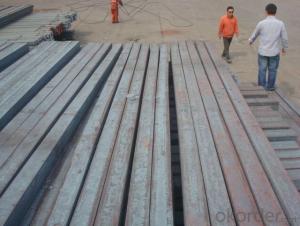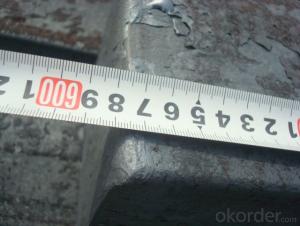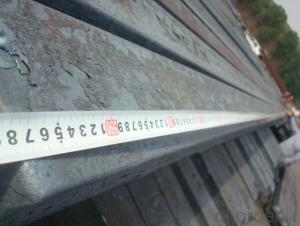Carbon Steel Billets Square Billets70mm 100mm 130mm 150mm 3SP
- Loading Port:
- Tianjin
- Payment Terms:
- TT OR LC
- Min Order Qty:
- 1000 m.t.
- Supply Capability:
- 30000 m.t./month
OKorder Service Pledge
OKorder Financial Service
You Might Also Like
STEEL BILLET
1.Brief description
Steel billet(ingot) by cogging or breakdown of semi-finished products, is the raw material of all kinds of steel mill. Billet section of square, round, flat, rectangular and abnormity of several kinds of, mainly related to the shape of rolled products.
2.Features
Rectangular billet continuous casting billet and mainly general carbon steel, low carbon low silicon cold-rolled material, high quality carbon structural steel, high strength low alloy steel, special steel, etc.
The billet is mainly divided into two kinds from the shape:
Slab: cross section width and height of the ratio of the larger, mainly used for rolling plate.
Billet: equal cross section width and height, or a huge difference, mainly used for rolling steel, wire rod. ,
Steel billets have distinct characteristics as compared with already furnished steel bars and products. Billets have a specific grain structure, which enables the metal to be processed more intricately. Steel billets are also known for their malleability and ductility, especially when exposed to varying temperatures during shaping and molding.
3.Processing
Steel billets are considered fresh and raw, and they must undergo a series of manufacturing processes before they can be used for various purposes. Billets are made by means of freezing molten liquid, and are later exposed to extremely low temperatures in order to allow the metal to take shape and solidify in chemical structure. The temperature manipulates the metal's physical properties, and tones its strength and durability. The subsequent processes provide the metal's curved mold design so that it can fit the allotted space provided by other machines, which complete the finishing procedures.
4.Pictures
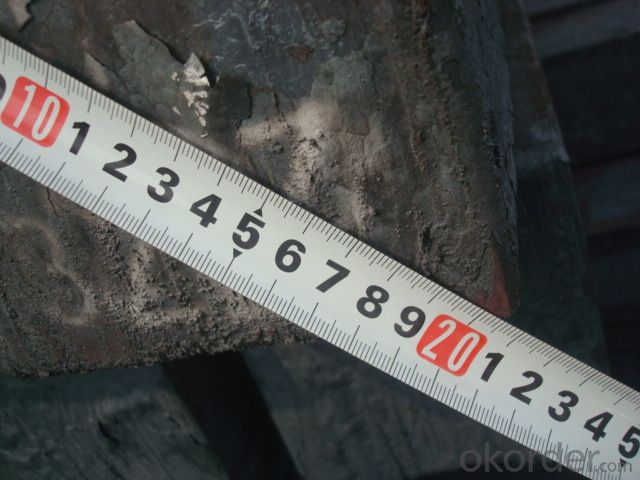
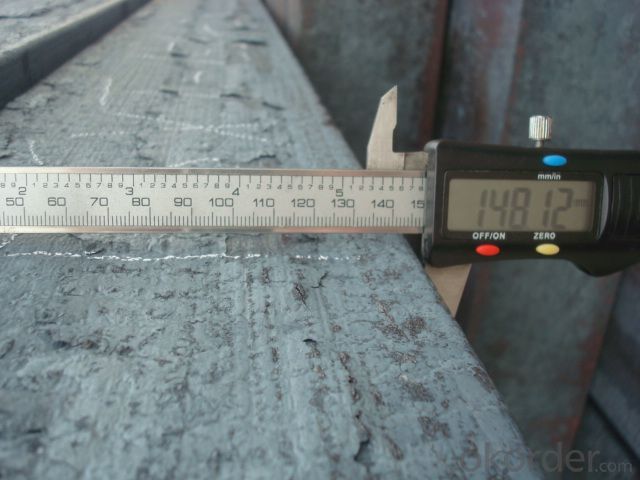
5.Usage
Billets, or ingots (as they sometimes referred to), are not of practical use until they have been formed into more functional shapes and sizes. While they have already been put in the furnace, they still require a series of shaping and molding procedures such as hot and cold working, milling and cutting before they are sold in hardware stores, or used for different applications. The unformed billets, however, can be used in striking currency such as coins and as reserves, similar to gold bars.
6.Detailed specification
Hot rolled billet steel
Size: 50x50mm-180x180mm
Steel Grade: 3SP, 5SP,Q195,Q235,Q255,Q275 Length:3m-12m
MOQ: 1000MT/size
Payment term: TT or LC
Packing: in bulk , bundle
Shipment: by container , bulk vessel
Packaging Details: bundles with steel strips or as customers's requirements
Delivery time: 15-30 days after the deposit
Loading port:Tianjin, or other port China
Origin : China
Inspection:Third party inspection before loading.
- Q:How are steel billets used in the production of steel cables?
- Steel cables require steel billets as a key component for their production. These billets act as the primary material from which the cables are made. The billets undergo a range of processes to manufacture the steel cables. Initially, the steel billets are heated in a furnace to extremely high temperatures, which makes them more pliable and easier to manipulate. This technique is referred to as annealing. Afterward, the billets are passed through a sequence of rollers to shape them into the desired form and size required for the cables. Subsequently, the shaped billets are fed through a wire drawing machine, where they are pulled through a series of dies to decrease their diameter and increase their length. This results in the formation of wire rods that resemble wires. These wire rods then undergo further processing in a series of machines to eliminate any impurities or surface defects. They are subsequently coated with lubricants to minimize friction during subsequent processes. The wire rods are then transferred to a wire stranding machine, where multiple wires are twisted together to form strands. These strands are then combined through either twisting or braiding to create the final steel cables. The cables are once again coated with lubricants to enhance their durability and resistance against corrosion. In summary, steel billets are of utmost importance in the production of steel cables, serving as the initial material for the entire manufacturing process. Through a combination of heating, shaping, and drawing processes, the billets are transformed into wire rods, which are further processed to produce the strands and ultimately the final steel cables.
- Q:How are steel billets used in the production of automotive steering systems?
- Automotive steering systems rely heavily on steel billets, a crucial element in their manufacturing. These billets, typically crafted from high-quality steel, serve as the raw material for producing various steering system components like shafts, gears, and housings. The production process begins by heating and softening the steel billets to increase their malleability. This allows them to be easily molded and shaped into the desired steering system components through methods such as forging, rolling, or casting. The chosen technique depends on the complexity and function of the component being manufactured. Once the desired shape is achieved, the steel billets undergo further processing to enhance their strength and durability. This involves employing heat treatment techniques like quenching and tempering, which provide the steel with specific mechanical properties like improved hardness and toughness. These treatments ensure that the steering system components can handle the considerable loads and vibrations experienced during operation. After proper shaping and treatment, the billets undergo precision machining processes to attain the required dimensional accuracy and surface finish. This includes cutting, drilling, and grinding the billets to create the necessary profiles and features that enable optimal functioning within the steering system. Lastly, the finished steering system components are assembled together with other parts to create the complete automotive steering system. These components, manufactured from steel billets, play a critical role in transmitting driver input to the wheels, enabling precise control and maneuverability of the vehicle. In summary, steel billets are indispensable in the production of automotive steering systems as they provide the necessary strength, durability, and precision required for safe and efficient vehicle steering.
- Q:How are steel billets used in the manufacturing of pumps and compressors?
- Steel billets are an essential raw material in the manufacturing process of pumps and compressors. These billets, which are essentially semi-finished steel forms, are used to create the various components and parts of pumps and compressors. The first step in utilizing steel billets is to heat them to a high temperature in order to make them malleable and ready for shaping. Once heated, the billets are then subjected to different types of metalworking processes such as forging, rolling, or extrusion. These processes help transform the billets into the desired shapes and sizes required for the specific components of pumps and compressors. In the manufacturing of pumps, for example, steel billets are used to create impellers, which are responsible for the movement and circulation of fluids. The billets are shaped into the required impeller design through machining or casting processes. Similarly, for compressors, steel billets are used to create components such as cylinders, pistons, and connecting rods, which are vital for the compression and movement of gases. The choice of steel billets in pump and compressor manufacturing is driven by their desirable properties such as strength, durability, and resistance to corrosion. These properties are crucial for ensuring the longevity and efficiency of these mechanical devices, especially when they are subjected to high pressures, temperatures, and harsh working conditions. Overall, steel billets play a fundamental role in the manufacturing of pumps and compressors as they provide the necessary raw material for shaping and creating the various components that enable these devices to function effectively.
- Q:How are steel billets used in the production of gears?
- Steel billets are used in the production of gears as the raw material from which the gears are manufactured. Billets are essentially semi-finished steel products that have a square or rectangular cross-section. They are heated and then hot-rolled into shape to form the desired gear. The first step in using steel billets for gear production is to select the appropriate grade of steel. The steel should have specific mechanical properties, such as high strength, toughness, and wear resistance, to ensure the gears can withstand the demanding conditions they will be subjected to during operation. Once the steel billets are selected, they are heated to a high temperature to make them malleable and easier to shape. This process, known as hot working, allows the steel to be deformed without cracking or fracturing. The billets are then passed through a series of rollers to form the desired shape and dimensions of the gear. After the initial shaping process, the gears may undergo further machining operations to refine their shape and improve their precision. This may include processes such as milling, grinding, or hobbing to remove excess material and create the final gear profile. These machining operations ensure that the gears meet the required tolerances and have smooth surfaces for optimal performance. Once the gears are machined to the desired specifications, they may undergo heat treatment processes such as quenching and tempering to enhance their mechanical properties. This helps to increase the hardness and strength of the gears, making them more durable and resistant to wear. Overall, steel billets play a crucial role in the production of gears as they serve as the starting material for the manufacturing process. Through heating, shaping, machining, and heat treatment processes, steel billets are transformed into high-quality gears that are strong, durable, and precisely engineered to meet the specific requirements of various mechanical applications.
- Q:What are the different types of steel billet inspection techniques?
- There are several different types of steel billet inspection techniques used in the industry. These techniques are employed to ensure the quality and integrity of the steel billets before they are further processed or used in manufacturing processes. Some of the commonly used inspection techniques include: 1. Visual Inspection: This is the most basic and commonly used technique where inspectors visually examine the steel billets for any surface defects, such as cracks, pits, or deformities. It is a quick and effective method for detecting obvious visual defects. 2. Dimensional Inspection: In this technique, the dimensions of the steel billet are measured using various tools, such as Vernier calipers or micrometers. This helps ensure that the billets meet the required dimensional specifications. 3. Ultrasonic Testing: Ultrasonic testing involves the use of high-frequency sound waves to detect internal defects or inconsistencies in the steel billets. This technique can identify defects like cracks, voids, or inclusions that may not be visible to the naked eye. 4. Magnetic Particle Inspection: This technique involves the application of magnetic fields to the steel billets and the use of iron particles or magnetic ink to identify surface and near-surface defects. It is particularly effective in detecting defects like cracks or discontinuities. 5. Eddy Current Testing: Eddy current testing utilizes electromagnetic induction to detect surface defects and measure the conductivity or thickness of the steel billets. It is a non-destructive technique that can identify defects like cracks, corrosion, or variations in material thickness. 6. Radiographic Testing: This technique involves the use of X-rays or gamma rays to inspect the internal structure of the steel billets. It can detect defects like inclusions, voids, or improper internal structure. 7. Dye Penetrant Inspection: Dye penetrant inspection is used to detect surface defects by applying a dye or fluorescent liquid to the steel billets. The dye seeps into any cracks or discontinuities, and excess dye is then wiped off, leaving only the dye trapped in the defects, which can be easily identified under UV light. These are some of the commonly used steel billet inspection techniques. Each technique has its own advantages and limitations, and the choice of technique depends on various factors such as the type and size of the billets, the level of defect detection required, and the budget constraints.
- Q:How are steel billets used in the manufacturing of hydraulic components?
- Steel billets are an essential raw material in the manufacturing of hydraulic components. Billets are essentially semi-finished forms of steel, typically in a rectangular or square shape, which are further processed into various hydraulic components such as cylinders, pistons, valves, and fittings. The manufacturing process begins with the selection of high-quality steel billets that meet specific mechanical properties and chemical composition requirements. These billets are then heated to a specific temperature to make them more malleable and easier to shape. Once heated, the billets are subjected to a series of mechanical processes such as forging, extrusion, or rolling to transform them into the desired shape and size. For example, in the production of hydraulic cylinders, the heated billets are typically forged or extruded to form the cylinder body. This involves applying intense pressure to the billet, causing it to deform and take on the cylindrical shape. The resulting cylinder body is then further machined to precise tolerances to accommodate internal components such as pistons, seals, and valves. Similarly, hydraulic valves and fittings are also manufactured using steel billets. The billets are machined using various machining techniques such as turning, milling, drilling, and grinding to create the intricate shapes and features required for these components. The final products are then heat-treated or surface-treated to enhance their strength, durability, and corrosion resistance. Steel billets are preferred in the manufacturing of hydraulic components due to their excellent mechanical properties, including high strength, good ductility, and weldability. These properties ensure that the components can withstand high pressures, extreme temperatures, and harsh operating conditions commonly encountered in hydraulic systems. In summary, steel billets are an integral part of the manufacturing process for hydraulic components. They are transformed through various mechanical processes to create the necessary shapes and sizes required for cylinders, pistons, valves, and fittings. The use of steel billets ensures the production of high-quality, reliable hydraulic components that can effectively perform in demanding hydraulic systems.
- Q:How are steel billets used in the production of reinforcing bars?
- Steel billets are an essential component in the production of reinforcing bars. These billets, which are semi-finished steel products, serve as the raw material for the manufacturing process. To produce reinforcing bars, the steel billets are heated to a specific temperature in a furnace. This heating process helps to improve the malleability of the steel, making it easier to shape and manipulate. Once the billets have reached the desired temperature, they are then passed through a series of rolling mills. These mills apply significant pressure to the billets, gradually reducing their size and shaping them into the required dimensions for reinforcing bars. The rolling process also helps to improve the mechanical properties of the steel, enhancing its strength and durability. After the rolling process is complete, the now elongated steel bars are cut into specific lengths according to the desired dimensions and requirements. These lengths are then allowed to cool, which helps to stabilize the steel and prevent any deformations. Finally, the reinforcing bars undergo a surface treatment process, such as hot-dip galvanization or epoxy coating, to provide corrosion resistance and improve their longevity. This treatment further enhances the performance and lifespan of the reinforcing bars, making them suitable for use in construction projects. In summary, steel billets are used as the starting material in the production of reinforcing bars. Through a series of heating, rolling, cutting, and surface treatment processes, the billets are transformed into high-strength steel bars that provide reinforcement to concrete structures.
- Q:Can steel billets be used in the manufacturing of machinery?
- Steel billets have the capability to be utilized in the production of machinery. These semi-finished metal products are typically either hot rolled or forged into various shapes, such as bars, rods, or sheets. Machinery components like gears, shafts, bearings, and structural frames are manufactured using these billets as the raw material. The utilization of steel billets in machinery manufacturing offers numerous benefits. Steel is renowned for its exceptional strength, durability, and resistance to wear, making it a suitable choice for heavy-duty applications. Furthermore, steel can be easily machined, welded, and molded into intricate shapes, facilitating the production of complex machinery parts. Moreover, due to its high melting point and thermal conductivity, steel is an ideal material for applications involving high temperatures or requiring heat transfer. Overall, steel billets are extensively employed in machinery manufacturing due to their outstanding mechanical properties, versatility, and dependability.
- Q:What is the role of steel billets in the manufacturing of automotive suspension systems?
- Steel billets play a crucial role in the manufacturing of automotive suspension systems as they serve as the raw material for producing various components like springs, shock absorbers, and control arms. These billets are heated, shaped, and machined to create strong and durable suspension parts that can withstand the forces and vibrations encountered while driving. Overall, steel billets are essential in ensuring the structural integrity and performance of automotive suspension systems.
- Q:What are the main factors affecting the hardenability of steel billets?
- The hardenability of steel billets, which refers to their ability to be hardened through heat treatment, is influenced by several key factors. These factors include the chemical composition of the steel, the rate at which it is cooled during quenching, and the size of its grains. First and foremost, the chemical composition of the steel plays a vital role in determining its hardenability. Elements like carbon, manganese, and alloying elements such as chromium, molybdenum, and nickel can have a significant impact on the steel's ability to be hardened. Higher carbon content and the presence of certain alloying elements increase the hardenability by forming carbides that aid in the formation of martensite, the hard and brittle phase responsible for the steel's hardness. The rate at which the steel is cooled during quenching is another crucial factor affecting its hardenability. Quenching involves rapidly cooling the heated steel billet, typically using a liquid medium like water or oil. The speed of cooling determines the transformation of the steel's microstructure. Faster cooling rates result in higher hardenability as they promote the formation of martensite. Conversely, slower cooling rates can lead to the formation of softer phases like ferrite or pearlite. The size of the steel's grains also impacts its hardenability. Smaller grain sizes provide more sites for the formation of martensite, resulting in improved hardenability. Grain refinement can be achieved through processes like alloying, heat treatment, and controlled cooling. Additionally, the presence of non-metallic inclusions, which act as areas of stress concentration, can also affect hardenability by promoting crack initiation and propagation during quenching. In conclusion, the main factors that influence the hardenability of steel billets are the chemical composition, cooling rate during quenching, and grain size. Understanding these factors and their interactions is crucial for achieving the desired hardness and mechanical properties in steel billets during heat treatment processes.
1. Manufacturer Overview |
|
|---|---|
| Location | |
| Year Established | |
| Annual Output Value | |
| Main Markets | |
| Company Certifications | |
2. Manufacturer Certificates |
|
|---|---|
| a) Certification Name | |
| Range | |
| Reference | |
| Validity Period | |
3. Manufacturer Capability |
|
|---|---|
| a)Trade Capacity | |
| Nearest Port | |
| Export Percentage | |
| No.of Employees in Trade Department | |
| Language Spoken: | |
| b)Factory Information | |
| Factory Size: | |
| No. of Production Lines | |
| Contract Manufacturing | |
| Product Price Range | |
Send your message to us
Carbon Steel Billets Square Billets70mm 100mm 130mm 150mm 3SP
- Loading Port:
- Tianjin
- Payment Terms:
- TT OR LC
- Min Order Qty:
- 1000 m.t.
- Supply Capability:
- 30000 m.t./month
OKorder Service Pledge
OKorder Financial Service
Similar products
New products
Hot products
Related keywords
